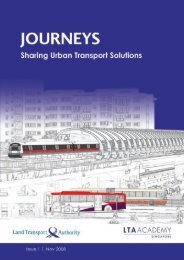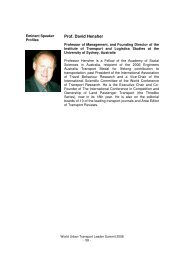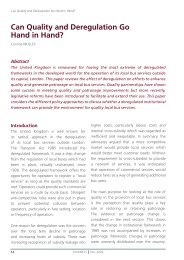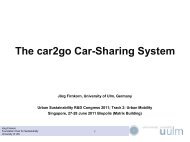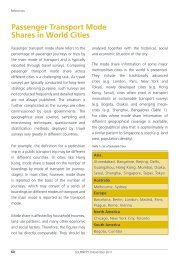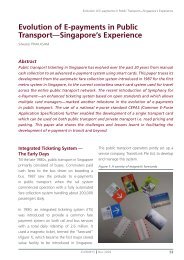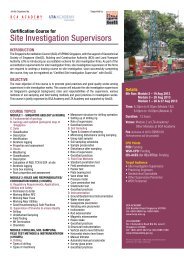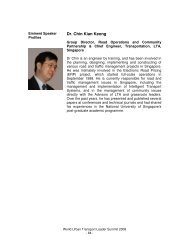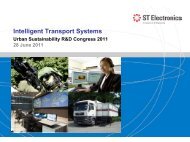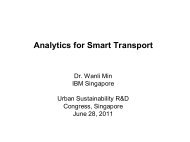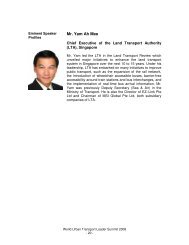Full Version - Issue 7 | November 2011 - LTA Academy
Full Version - Issue 7 | November 2011 - LTA Academy
Full Version - Issue 7 | November 2011 - LTA Academy
Create successful ePaper yourself
Turn your PDF publications into a flip-book with our unique Google optimized e-Paper software.
Urban Sustainability and Transportation: Research Framework for Medium and Long Term Transport Planning<br />
Figure 3: Representation of the public transport supply in Singapore in first quarter of 2010.<br />
(Width indicates capacity, brown lines represent buses, and other colours represent various MRT/LRT lines)<br />
transport demand model, which allows<br />
further refinement of the approach.<br />
In terms of bus operations, the research will<br />
build on earlier work proposing an adaptive<br />
control scheme to mitigate the problem of<br />
bus bunching (Daganzo 2008). The MATSim<br />
simulation allows for integration of the<br />
proposed scheme which dynamically<br />
determines bus holding times at control<br />
points based on simulation-based, real-time<br />
headway information. Finally, the findings<br />
of Tirachini and Hensher (<strong>2011</strong>) on the<br />
influence of fare collection systems and<br />
optimal infrastructure investments will be<br />
incorporated and applied to the Singapore<br />
scenario.<br />
Long Term<br />
The urban system is constantly evolving. It<br />
is changing at different speeds and scales.<br />
Endogenous and exogenous agents and forces<br />
accelerate or delay these changes. Current<br />
urban land use and transport models focus<br />
their attention on the impact of accessibility<br />
changes arising from shifts, reductions or<br />
increases in the general transport cost surface.<br />
They do so by employing spatial aggregates<br />
or zones as their reference system. They<br />
assume many atomistic actors, who interact<br />
freely in an open land and housing market.<br />
So far, the first characteristic has been the<br />
result of data availability considerations and<br />
not of theoretical desirability. The second<br />
assumption reflects both American and<br />
European conditions, but is clearly untenable<br />
for other places such as China or Singapore,<br />
where land availability, land use and household<br />
capital availability are jointly regulated by the<br />
government. In Singapore, for example, the<br />
government controls land use, a vast share<br />
of the property market and pensions through<br />
instruments, such as, government land sales,<br />
Housing and Development Board (HDB) or<br />
Central Provident Fund (CPF) and their various<br />
rules and regulations (Phang 2001).<br />
JOURNEYS | <strong>November</strong> <strong>2011</strong><br />
11



